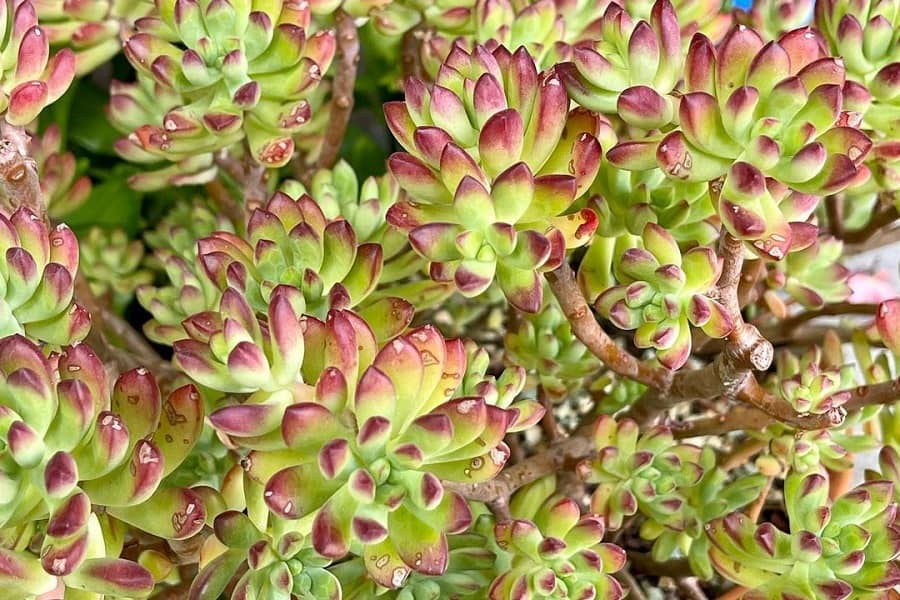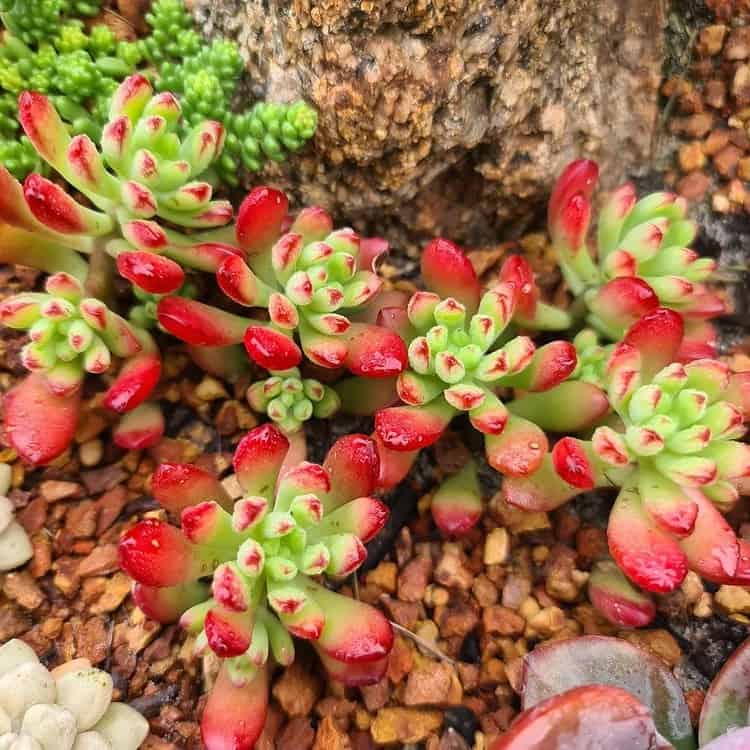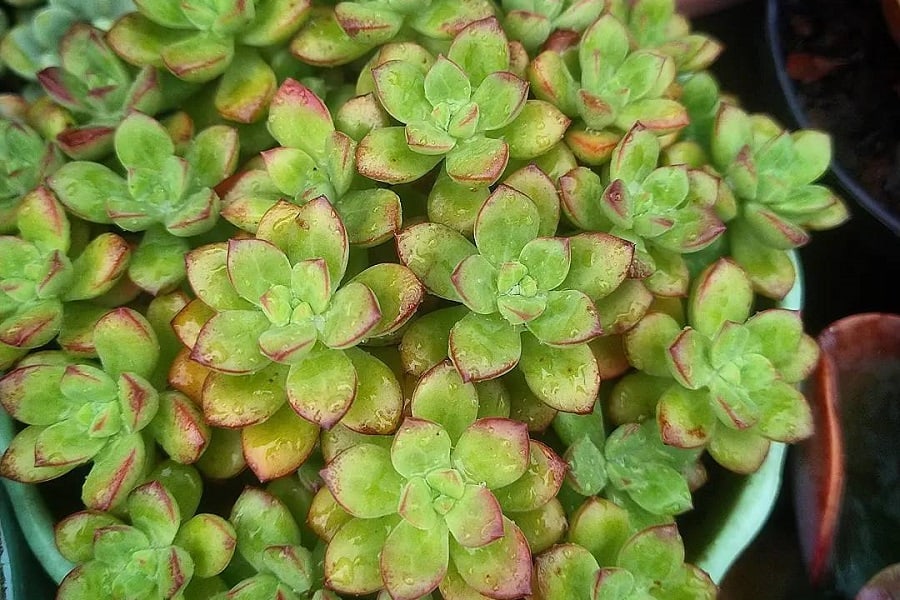Echeveria macdougallii: The Mexican Stunner That Will Transform Your Garden Overnight
Are you looking to add a vibrant pop of color to your succulent collection? Look no further than the eye-catching Echeveria macdougallii! With its pastel green leaves adorned with red and pink margins, this Mexican native is an absolute showstopper. But wait, there’s more! As winter approaches, the colors intensify, making it even more irresistible. Prepare to be dazzled by this jelly bean-like succulent that’s sure to steal the limelight in your garden.

Contents
About Echeveria macdougallii
Native to the arid regions of Oaxaca, Mexico, Echeveria macdougallii is a stunning succulent that forms rosettes atop upright stems. These rosettes are composed of fleshy, jelly bean-textured leaves that will have you doing a double-take. During the spring and summer, the leaves flaunt a pastel green hue with vibrant red and pink edges. But as the cooler months roll in, the colors deepen and intensify, creating a mesmerizing display.
Despite its delicate appearance, Echeveria macdougallii is a hardy plant that thrives with minimal care. And if that’s not enough to pique your interest, these beauties also produce tiny tubular blooms measuring around 0.2 inches long, adding an extra touch of charm to your garden.
Check this out:
160+ Amazing Echeveria Types with Pictures
Echeveria macdougallii Care Guide
Light Requirements
Echeveria macdougallii loves to bask in the sun, so provide it with plenty of bright, direct light. Aim for at least 4 to 5 hours of sunlight daily, whether outdoors during the summer or near a sunny window indoors. If you’re short on natural light, consider using a grow light to ensure your succulent stays happy and vibrant.
Grow lights are a game-changer for indoor succulents, mimicking the intensity of natural sunlight. Position the grow light about 6 to 12 inches above the plant, and leave it on for 12 to 16 hours per day. Adjust the distance and duration as needed, keeping an eye out for signs of stretching or sunburn.
Watering Needs
Like most succulents, Echeveria macdougallii is drought-tolerant and prefers its soil to dry out completely between waterings. During the active growing season (spring and summer), water every 7 to 14 days, ensuring the soil is thoroughly soaked and excess moisture drains away. In the winter months, you can cut back on watering, allowing the soil to dry out for longer periods.
When watering, pour the liquid directly onto the soil, avoiding the rosette to prevent rot and fungal issues. And remember, it’s better to underwater than overwater this succulent beauty.
Soil Preferences

To keep your Echeveria macdougallii happy and healthy, it’s essential to provide a well-draining soil mix. A cactus or succulent potting mix from your local nursery or garden center is an excellent choice. These mixes are specially formulated to ensure proper drainage and airflow, preventing waterlogged conditions that can lead to root rot.
If you prefer to create your own blend, combine equal parts potting soil, perlite or pumice, and coarse sand. This DIY mix will mimic the well-draining conditions that Echeveria macdougallii loves.
Fertilizing
While not strictly necessary, a light application of a balanced, water-soluble fertilizer can give your Echeveria macdougallii an extra boost during its growing season. Opt for a cactus or succulent-specific fertilizer, diluted to half or quarter strength, and apply it every 4 to 6 weeks from spring to early fall.
Overfertilizing can lead to fertilizer burn, so it’s best to err on the side of caution. If you notice any signs of distress, such as discoloration or leaf drop, flush the soil thoroughly with water to remove any excess fertilizer.
Temperature and Humidity
Echeveria macdougallii thrives in warm, dry conditions, making it an ideal houseplant or outdoor plant in hot, arid climates. Indoors, aim for temperatures between 65°F and 80°F (18°C to 27°C) during the growing season, and slightly cooler temperatures around 60°F (15°C) in the winter.
Outdoors, this succulent loves warm summers with temperatures above 70°F (21°C). As for humidity, Echeveria macdougallii prefers low to moderate levels, around 40% to 50%. Higher humidity can lead to problems like root rot, so ensure proper air circulation and avoid overcrowding your plants.
Pests and Problems
While generally hardy, Echeveria macdougallii can sometimes fall victim to common succulent pests like mealybugs, scale insects, and spider mites. Keep an eye out for any signs of infestation, such as white cottony masses, sticky residue, or webbing, and treat promptly with an insecticidal soap or neem oil solution.
Root rot, caused by overwatering or poor drainage, is another potential issue. If you notice mushy, discolored leaves or a foul odor, it’s likely due to rot. In this case, remove the affected parts, let the plant dry out, and consider repotting in fresh, well-draining soil.
Pruning
Echeveria macdougallii doesn’t require frequent pruning, but you may need to remove any dead or damaged leaves or stems to maintain its attractive appearance. Use clean, sharp scissors or pruning shears to make clean cuts, and avoid pulling or twisting the leaves, as this can damage the plant.
Potting and Repotting

When it comes to potting, choose a container with drainage holes to prevent waterlogging. Echeveria macdougallii appreciates a snug fit, so select a pot that’s slightly larger than the root ball.
Repotting is typically necessary every 2 to 3 years, or when the plant becomes rootbound. Spring is the ideal time for repotting, as the plant is entering its active growth phase. Gently remove the plant from its current pot, shake off any excess soil, and replant in a fresh, well-draining cactus or succulent mix.
Echeveria macdougallii Propagation Methods
Echeveria macdougallii can be easily propagated through offsets, leaf cuttings, or seeds, allowing you to expand your collection or share these beauties with friends and family.
Offsets:
- Look for small rosettes or plantlets growing from the base of the mother plant
- Gently twist or cut them off, ensuring you get a few roots attached
- Plant the offsets in a well-draining soil mix and water lightly
- Keep the soil moist until roots establish, then treat it like a mature plant
Leaf Cuttings:
- Carefully twist off a few healthy leaves from the mother plant
- Allow the leaf cuttings to callus over for a few days
- Plant the calloused ends just below the soil surface
- Keep the soil lightly moist, and new plants will sprout from the leaf bases in a few weeks
Seeds:
- Sow Echeveria macdougallii seeds in a well-draining seed-starting mix
- Cover the seeds lightly with soil, as they need some light to germinate
- Keep the soil moist but not waterlogged, and provide bright, indirect light
- Once sprouted, allow the seedlings to develop their first set of true leaves before transplanting
No matter which propagation method you choose, Echeveria macdougallii is an obliging plant that will reward you with delightful new offsets, leaf babies, or seedlings. With a little patience and care, you’ll soon have a colorful army of these candy-coated charmers to brighten up your garden.
